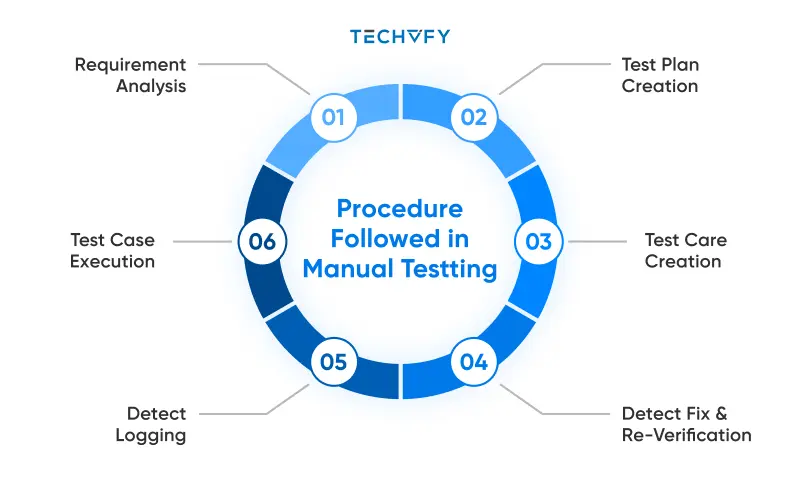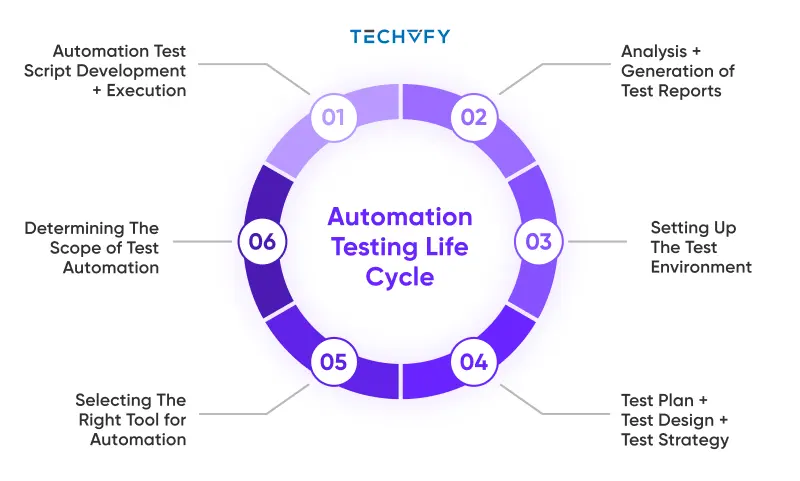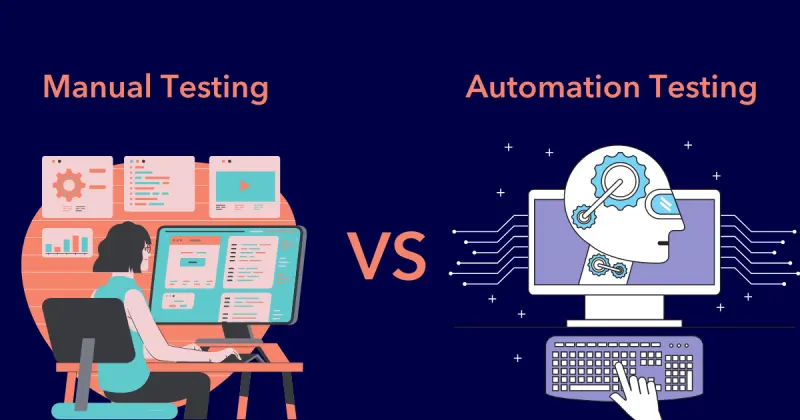Difference Between Manual Testing and Automation Testing: Updated Guide 2025
- TECHVIFY Team
- 0 Comments
Consumers expect their applications to work flawlessly every time they use them. If your app is riddled with performance issues, bugs, and glitches, it can quickly lose its user base due to poor quality. As a result, testing your software is essential to ensure project teams thoroughly check, verify, and validate the functionality of the developed product, thereby delivering an optimal user experience.
In today’s fast-paced development environment, both manual and automated testing are often used together to produce high-quality software for customers. Each approach has its strengths and limitations, and understanding when to use them is key to successful testing.
This blog will cover manual and automated testing fundamentals, highlight the difference between manual testing and automation testing, and explore the best scenarios for each method.
I. Breakdown The Definition: What is Manual Testing and Automation Testing
Manual Testing
Manual testing involves testers performing test cases by hand, without the aid of automated tools, and relying on any automation tools. In this approach, testers take on the role of an end user, methodically exploring the software to identify any unexpected behavior or bugs. This process plays a fundamental role in the software development lifecycle by ensuring the software is user-friendly and free from errors before it reaches its intended audience. Manual testing focuses on key aspects such as functionality, usability, and performance, providing a hands-on assessment that automation tools may overlook.
Key Characteristics of Manual Testing
- Human observation: Relies on the tester’s cognitive abilities to detect subtle issues that could be missed by automated scripts.
- Flexibility: Allows testers to quickly adapt to changing requirements and explore new areas of the software without the need for script modifications.
- User experience focus: Essential for evaluating the application’s usability and overall feel from the perspective of a real end user, ensuring a seamless experience.
Test Automation
Test automation is the process of using specialized software tools, such as Jenkins, CircleCI, Travis-CI, GitLab CI/CD, GitHub Actions, Bamboo, and Azure Pipelines, to run predefined test scripts on software prior to its release into the production environment. These tools can run tests repeatedly at any time, significantly improving the efficiency, accuracy, and coverage of the testing process.
Automation is particularly valuable for quickly identifying defects, ensuring that new features or changes do not break existing functionality (regression testing), and improving the overall quality of the software. It is especially beneficial for large-scale projects where manual testing would be too time-consuming and prone to human error.
Key Characteristics of Test Automation
- Scripted execution: Automated tests follow predefined steps, ensuring consistency and repeatability across different environments.
- High efficiency: Capable of running tests much faster than manual testing, particularly advantageous for extensive regression testing.
- Scalability: Easily handles a high volume of test cases and complex testing scenarios, ensuring thorough coverage for large and intricate projects.
II. Manual vs Automation Testing: How Do They Work
How To Perform Manual Testing
Regardless of the type of testing employed, all testers must follow the Software Testing Life Cycle (STLC). This structured process consists of six key stages designed to ensure that all software quality objectives are met.
The first stage, Requirement Analysis, provides the QA team with a comprehensive understanding of the testing objectives. This foundational step allows them to create a detailed Test Plan, which outlines the specific steps to execute the tests and defines the expected results.
Once the test environment is set up, testers manually execute the test cases and record the outcomes. If any bugs are identified, they document the details and communicate them to the development team, who will begin troubleshooting the issues. After the development team resolves the defects, the QA team manually retests the impacted functionality to ensure the bug has been successfully fixed.
Differentiate between manual and automation testing
Manual testing can be very labor-intensive. Testers are required to manually enter test data, interact with application elements, and repeat these actions with each code change to ensure nothing is broken. This repetitive process, such as logging in and out after every update to verify the login functionality, can be exhausting but is critical, as a malfunctioning login system could have severe business implications.
Example: Manual Testing for an eCommerce Website
To illustrate the workload involved in manual testing, let’s consider an eCommerce website. Numerous features and functionalities need to be tested, including:
- User registration: Enter the required details (name, email, password, phone number), click register, confirm that the user receives a verification email, and verify that the user can log in using the credentials.
- Product Search: Test the search functionality using different search terms and confirm the results are accurate and relevant.
- Product details: Ensure all product information (name, price, description, images, reviews) is displayed correctly.
- Add to cart: Add products to the cart and verify that the correct product information, quantity, and total price are displayed.
- Checkout procedure: Input accurate shipping and billing details, complete the purchase, and verify that the order has been placed successfully with a confirmation email.
- Payment methods: Test various payment options (credit card, PayPal) and ensure payments are processed correctly.
- Account management: Verify that users can edit their profile, view order history, and manage saved payment methods.
- Accessibility: Verify that the website is usable by individuals with disabilities, such as those using screen readers or keyboard-only navigation.
How To Perform Automation Testing
Automation testing involves executing test scripts that simulate user actions and interactions with the software in a predefined sequence. To begin, a Test Framework is essential. This framework equips testers with the necessary tools to create, execute, debug, and manage automated test scripts.
Organizations generally have two options: purchase a testing tool from a vendor, which comes with built-in test frameworks, or build their own framework using open-source libraries. While building an in-house solution offers greater customization and ensures better compatibility with the existing tech stack, it requires significant time and resources. On the other hand, purchasing a tool allows teams to get started quickly, thanks to the availability of pre-built features.
What is manual testing and automation testing
Once the tools and frameworks are in place, automation testing follows the same Software Testing Life Cycle. The process begins by identifying which test cases to automate, typically focusing on repetitive, time-consuming, and critical tasks.
Next comes Test Case Development. Popular libraries like Selenium are often used to create test scripts. Many automation tools also come with built-in keywords for common actions (e.g., click, input) and validations (e.g., check if an element is present). These keywords can be customized and parameterized for different scenarios. For example, a “click” keyword might accept an element’s ID or name as a parameter to perform the action.
Have a Project Idea in Mind?
Get in touch with experts for a free consultation. We’ll help you decide on next steps, explain how the development process is organized, and provide you with a free project estimate.
III. Difference Between Manual Testing and Automation Testing
For your convenience, we have prepared a side-by-side comparison of the two testing approaches:
| Aspects | Manual Testing | Automation Testing |
|---|---|---|
| Definition | Testing software manually by humans without automation tools or scripts. | Utilizing automation tools or human-written scripts to test software |
| Human Intervention | Requires significant human intervention and manual effort. | Requires minimal human intervention once scripts are set up. |
| Speed | Relatively slow due to manual execution. | Significantly faster as tests are executed by tools. |
| Reliability | Prone to human errors. | More reliable as it eliminates human error. |
| Reusability | Test cases are harder to reuse. | Test cases can be easily reused across multiple cycles. |
| Cost | Can be expensive due to ongoing human resource needs. | Higher initial costs but cheaper over time as tests are reused. |
| Scope | Limited scope due to time and effort constraints. | Broader scope as more tests can be executed in less time. |
| Complexity | Struggles with complex tests requiring multiple iterations. | Can handle complex tests with ease using scripts. |
| Accuracy | Depends on the tester’s skill and experience. | More accurate as it follows predefined rules and logic. |
| Maintenance | Easier to maintain as there are no scripts to update. | Requires ongoing maintenance of scripts and tools. |
| Skillset | Requires skilled manual testers. | Requires skilled automation engineers or developers. |
IV. Difficulties When Applying: Automation Testing vs Manual Testing
Automation Testing
- Reduced Intuition
Automated testing lacks the human insight that manual testing offers. This makes it less effective in areas requiring non-functional testing, such as usability, where human intuition and judgment are crucial. Automation tools follow predefined instructions and cannot understand subjective aspects like user experience or visual aesthetics. - Limited Flexibility
Automation tools are confined to the parameters of the test scripts. They cannot adapt or think beyond the predefined scenarios. Your testing may miss critical issues if the test scripts do not account for edge cases or unexpected inputs. Automation is rigid and cannot handle exploratory testing as efficiently as humans. - Higher Costs
The initial investment in automated testing can be substantial. It requires purchasing or developing automation tools, building frameworks, and training staff to use and maintain these systems proficiently. Additionally, the cost of ongoing script maintenance can add up as the project evolves and new features or updates are introduced. - Potential Over-Complexity
Automated testing might not be the best fit for smaller projects or teams. The tools and frameworks can be overly complex and resource-intensive, making them difficult to justify for projects with limited scope. In such cases, the time and money spent on automation may outweigh its benefits, especially if the project doesn’t require frequent re-testing.
Manual Testing
- Time-Consuming and Labor-Intensive
Manual testing relies entirely on human effort, which makes it slower than automated testing. Testers must manually execute all test cases, input data, and validate results, which can be particularly inefficient for large applications or datasets. This process is also prone to delays, especially when multiple test cycles are required. - Susceptibility to Human Error
Since manual testing involves human execution, there’s a higher chance of errors, especially during repetitive tasks like regression testing. Testers may miss small errors in the code or overlook issues due to fatigue or oversight. This is particularly problematic in white-box testing, where testers need to carefully analyze the code’s logic and structure. - Resource Demands
Hiring and training manual testers can be expensive, particularly when specialized skills are required. Depending on your industry, you may need to hire testers with expertise in certain types of testing or knowledge of specific tools. Additionally, retaining skilled testers can be a challenge in a competitive QA market, where demand often exceeds supply. - Inconsistency
Manual testing can lead to inconsistent results, as the outcomes depend on the individual tester’s focus and experience. Human concentration fluctuates, and when team members change, the quality and thoroughness of testing may vary. This inconsistency can lead to missed bugs or incomplete test coverage. - Limited Test Coverage
Manual testing is less suited for large-scale system testing that involves numerous test cases. Achieving comprehensive test coverage is difficult because manual testers are limited by time and effort. As a result, some parts of the application might not get tested as thoroughly, leading to potential issues being overlooked.
V. Manual vs Automation Testing: Which One to Choose?
The discussion surrounding manual versus automated testing has continued ongoing in the software testing field for quite some time. Deciding which approach to use depends on a clear understanding of the software’s scope, the target audience, and the requirements. Let’s dive deeper into the core differences and benefits of each approach.
When to Choose Manual Testing?
Despite the growing prevalence of automation, manual testing still has its place in certain scenarios.
Early Development Stages
Manual testing is often the best choice during the early stages of development when the software is still evolving. At this point, the application is typically unstable, and investing in automation may not be cost-effective. Manual testing allows for quick identification of bugs and bottlenecks, with faster turnaround times for fixes.
Ad-Hoc Testing
Ad-hoc testing, where QA specialists randomly test various functionalities without predefined test cases, is best suited for manual execution. This unstructured testing approach allows testers to explore the system and identify unexpected issues.
UI Testing
Testing the visual aspects of the user interface (UI) is another area where manual testing excels. Testers can manually assess design elements, detect visual defects, and ensure that the UI matches the intended layout. Manual testing for UI also reduces the risk of false negatives, which can cause unnecessary extra work for development teams.
UX and Exploratory Testing
Manual testing is ideal for exploratory testing and evaluating user experience (UX). These tests involve assessing how real users interact with the software, providing valuable insights that automation tools cannot replicate. Additionally, manual testers can handle complex, nuanced scenarios that may not be suitable for automation.
Difference between manual testing and automation testing
When to Choose Automation Testing?
Automation testing is particularly useful in scenarios where manual testing falls short.
Regression Testing
Automation shines in regression testing, where the same test cases must be executed repeatedly after each update or change to ensure the system hasn’t been broken. Automated regression testing is faster, more reliable, and more consistent than manual testing.
Cross-Browser and Cross-Platform Testing
When testing across multiple browsers, devices, and operating systems, automation is the clear choice. It allows tests to be executed simultaneously across different environments, saving time and ensuring thorough compatibility checks.
High-Frequency Testing
For tests that need to be run frequently, automation is more efficient. These tests can be scheduled to run at any time, without the need for manual intervention. This is particularly useful for large-scale projects with extensive testing needs.
Conclusion
Guaranteeing that your application provides a seamless user experience is non-negotiable. Whether you’re leveraging manual testing for its intuitive and flexible approach or embracing automation testing for its speed and scalability, both strategies play crucial roles in maintaining software quality. Each testing method has its strengths and is best suited for specific stages of development or types of testing.
However, mastering the difference between manual testing and automation testing requires expertise and careful planning. At TECHVIFY, we specialize in delivering tailored, high-quality software solutions that meet your business needs. Let our team of experts guide you through the best testing practices to ensure your software works perfectly—every time.
Contact TECHVIFY today for a free consultation. Don’t leave your software’s success to chance—partner with the professionals and ensure it’s built to perform.
TECHVIFY – Global AI & Software Solutions Company
For MVPs and Market Leaders: TECHVIFY prioritizes results, not just deliverables. Reduce time to market & see ROI early with high-performing Teams & Software Solutions.
- Email: [email protected]
- Phone: (+84)24.77762.666








